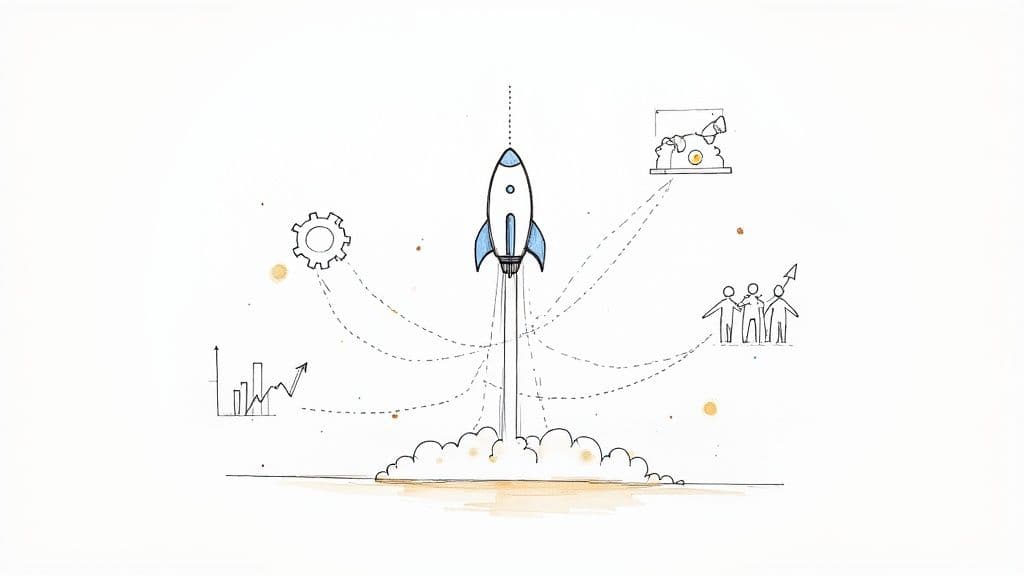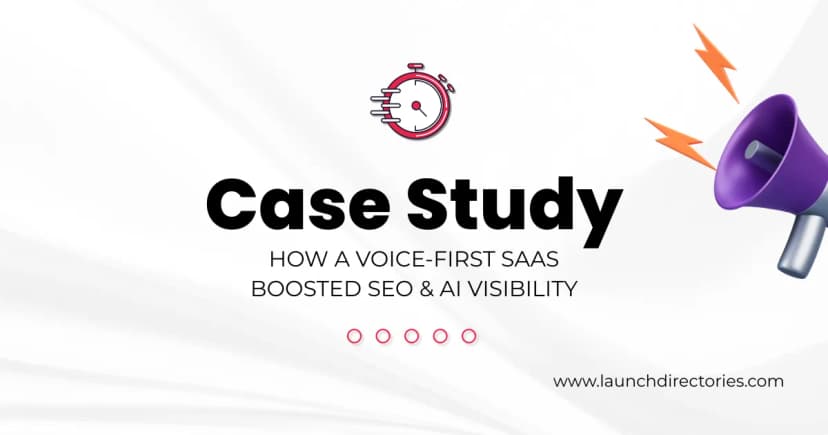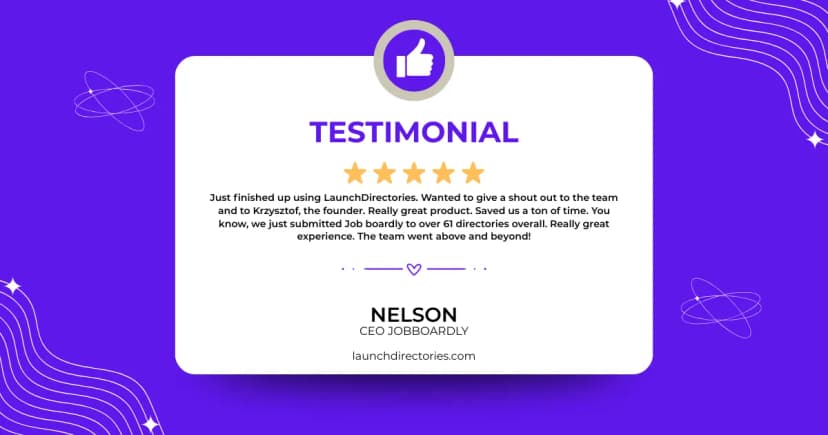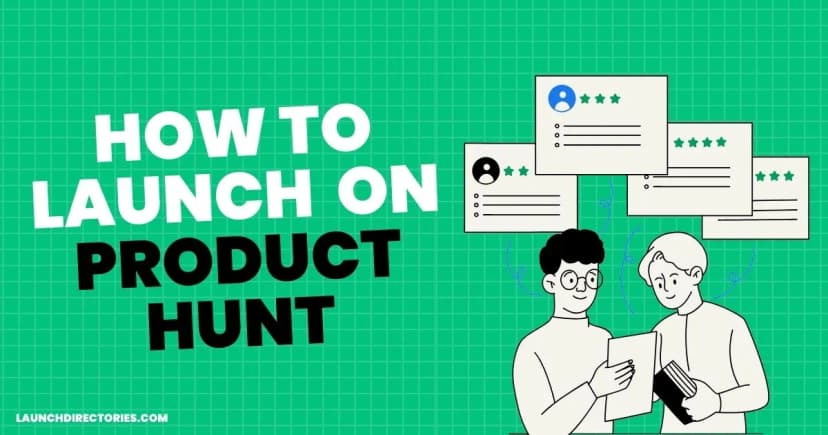Launching a new product comes down to one core idea: create a strategic blueprint before you do anything else. This isn’t just a document; it’s your compass, grounded in deep market knowledge, a crystal-clear picture of your ideal customer, and specific, measurable goals that guide every single decision you make.
Building Your Pre-Launch Strategic Blueprint
Every successful launch I've ever seen started long before "launch day." It's a classic founder mistake to believe a great product will just sell itself. The reality is the market is far too noisy for that to work anymore. The real foundation is a detailed strategic blueprint that anticipates hurdles and maps out the path to your first customers.
This is your research and self-assessment phase. You need to dig deeper than surface-level assumptions and truly get inside your customer's world. What are their biggest headaches? What have they already tried? And where do those solutions fall flat? Answering these questions lets you nail down a razor-sharp value proposition—a simple, powerful statement explaining the one thing your product does better than anyone else.
Defining Your Launch Objectives
Once you know your customer and your unique spot in the market, you need to set clear, measurable goals. Vague targets like "get more users" are practically useless. Instead, use the SMART framework (Specific, Measurable, Achievable, Relevant, Time-bound) to create goals that actually mean something.
For instance, a real, actionable SMART goal looks like this:
- Specific: Acquire 100 new paying customers.
- Measurable: Tracked via our payment processor dashboard.
- Achievable: Based on our pre-launch email sign-ups and estimated conversion rates.
- Relevant: This number validates our initial market fit and provides the revenue we need for Q2.
- Time-bound: Within the first 30 days post-launch.
This visual breaks down the simple, three-stage journey from an initial idea to being truly launch-ready.
As the diagram shows, a solid launch is a step-by-step process. Each stage builds on the last, which helps you avoid costly mistakes down the line.
Understanding the Competitive Landscape
At the same time, you have to dissect your competition. Don't just look at what they do well; hunt for what they don't do. Are their prices too high? Is their user experience clunky and frustrating? Is their marketing message a confusing mess? These are the gaps in the market—the opportunities your product can exploit. This analysis will directly shape your messaging and positioning.
Launching something new is incredibly tough. In the consumer goods sector alone, a staggering 80-90% of new products fail within 18 months. That stat alone should tell you how critical a solid pre-launch plan really is.
Before we move on, let's put the core components of this go-to-market strategy into a simple table. Think of this as your quick-reference checklist to make sure you have all your bases covered.
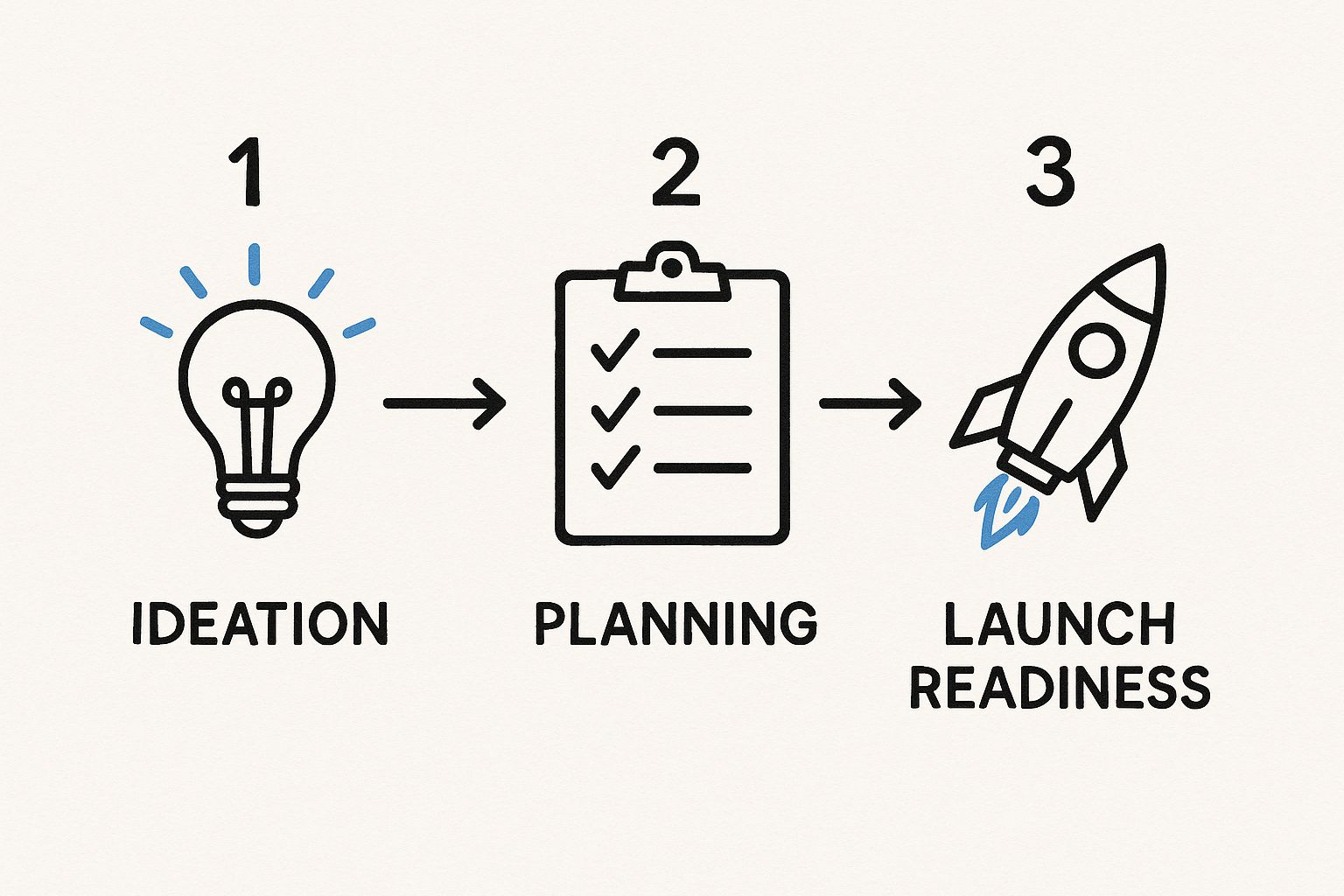
Core Components of a Go-To-Market Strategy
| Component | Key Objective | Example Metric |
|---|---|---|
| Market Research | Identify and understand the target audience's pain points. | 25+ customer interviews completed |
| Competitive Analysis | Pinpoint market gaps and define a unique value proposition. | SWOT analysis of 3 top competitors |
| SMART Goals | Set clear, measurable targets for the launch period. | Acquire 1,000 new users in 30 days |
| Positioning Statement | Articulate how the product solves the customer's problem. | "For [target customer] who [has this problem], our product is a [category] that [provides this benefit]." |
| Channel Strategy | Determine the most effective channels to reach the target audience. | 70% of traffic from organic search & directories |
This table summarizes the foundational work that guides every decision you'll make from here on out. It's the bedrock of a launch that has a real chance of succeeding.
Key Takeaway: Your pre-launch blueprint isn't just a document; it's your go-to-market compass. It ensures every action—from writing a tweet to submitting to a directory—is purposeful and aligned with your core business objectives.
This foundational work also makes your channel selection a whole lot easier. When you're deciding where to announce your product, knowing your audience is everything. For most startups, exploring a variety of platforms is the right move, which is exactly why we put together a guide on Product Hunt alternatives where founders should launch to help you find the perfect fit.
Creating Your Narrative and Building Pre-Launch Hype

With your strategic blueprint locked in, it’s time to shift gears from planning to captivating. A great product is only half the equation; the other half is a story that makes people feel something. This is where you build the emotional connection that turns curious observers into your first paying customers.
Your product's story is so much more than a list of features. It’s the "why" behind what you built. Frame your product as the hero in your customer's journey—the tool that finally helps them crush a frustrating problem or reach a goal they've been chasing. Forget the technical specs for a moment and focus on the transformation your product makes possible.
Develop a Multi-Channel Communication Plan
Once you've nailed down your core story, you need a plan to tell it everywhere your audience lives online. A multi-channel plan isn't about spamming every platform with the same message. It's about tailoring your narrative to fit the vibe of each channel, creating a consistent and immersive experience that builds momentum.
For example, your story could unfold like this:
- LinkedIn: Share a professional, thoughtful post about the industry problem your product solves.
- Twitter/X: Post short, engaging behind-the-scenes clips of the team building the solution. Show the human side.
- Email List: Send an exclusive sneak peek or a personal letter from the founder explaining the mission behind it all.
The goal here is to create a steady drumbeat of anticipation. Each piece of content should build on the last, revealing a little more and pulling your audience deeper into your world. This creates a powerful sense of momentum that peaks on launch day.
Recent data shows just how critical this multimedia approach is. In fact, 67% of launches now use video-first content to drive market acceptance. This, combined with community-first strategies and AI-powered personalization, is a potent mix for modern launches. You can dig into more of these tech product launch statistics and insights to see what's actually working right now.
Key Insight: Don’t just announce your product—tell its story. A powerful narrative creates an emotional investment that features and specs alone can never achieve.
Build a Community of Early Adopters
One of the most powerful assets you can have is a built-in audience on day one. Building a community of early adopters before you launch isn't just about collecting email addresses; it's about creating a group of passionate advocates. These are the people who will give you priceless feedback and become your first evangelists.
Think about creating a private space for these early fans:
- A Private Beta Group: Invite a select few to test the product, find bugs, and suggest improvements. Their feedback is gold, and making them feel like insiders builds immense loyalty.
- An Exclusive Email List: Offer special pre-launch content, early access, or a unique discount to those who sign up. This segment is your most engaged audience—treat them like VIPs.
- A Niche Subreddit or Discord Server: Platforms like Reddit can be fantastic for finding your first users. Creating a dedicated space allows for raw, honest conversations and helps you build real rapport. For a deeper dive, check out our guide on how to launch a startup on Reddit to connect with these communities authentically.
By nurturing this core group, you ensure that when you finally launch, you’re not shouting into an empty room. Instead, you'll have a chorus of voices ready to amplify your message.

This is it. The moment all your planning and pre-launch buzz leads up to. But launch day isn’t just about flipping a switch and hoping for the best; it’s a carefully orchestrated event where your prep work meets real-time execution. A smooth launch day amplifies the momentum you’ve worked so hard to build.
Success here really comes down to a detailed, hour-by-hour timeline. This isn't just another checklist. Think of it as your command center document, outlining every single action from the final website checks to the exact minute social media posts go live. Every person on your team needs to know their role cold—no ambiguity, no confusion.
Synchronizing Your Multi-Channel Push
Your launch day marketing should hit like a coordinated blast across every channel, not a slow, disjointed trickle. This unified push creates a powerful sense of an "event," making people feel like they need to pay attention right now.
For this to work, every single asset has to be finalized and queued up well in advance. I’m talking about your email announcements, your blog posts, your social media graphics—everything.
Here are a few non-negotiable actions for your timeline:
- Final Technical Sweep: Run one last stress test on your website or app. You need to be sure it can handle the traffic spike you’re expecting.
- Support Team Briefing: Your customer support team needs to be fully prepped with FAQs and ready for an influx of questions. No surprises.
- Scheduled Communications: Use scheduling tools to make sure your emails, blog posts, and social media announcements all go live at the precise launch moment.
A well-timed launch also means showing up on platforms where your audience is already active, and for many startups, that includes dedicated launch sites. If you're targeting a community like Product Hunt, you’ll find that timing and preparation are absolutely everything. Our guide details exactly how to launch successfully on platforms like Product Hunt, breaking down how to align your messaging and engage with the community for the best results.
Pro Tip: Assign a single "launch commander." This person’s only job is to follow the timeline, coordinate the team, and make quick decisions. It prevents chaos and keeps everyone on the same page when things inevitably get hectic.
Monitoring Performance in Real Time
Once you’re live, your job shifts from execution to observation. You can't just launch and walk away; you need to be glued to your analytics. Monitoring key metrics in real time is what lets you react instantly to problems or, even better, unexpected opportunities.
Set up a dedicated dashboard tracking these critical metrics:
- Website Traffic: Are you seeing the spike you anticipated from your email and social channels?
- Conversion Rate: How many visitors are actually signing up or buying?
- Server Load: Is your infrastructure holding up, or is it starting to sweat?
- Social Mentions: What are people saying? Are there questions you can jump on immediately?
This immediate feedback loop is priceless. If you notice a particular channel is driving way more traffic than you expected, you can double down on it. If a few users are reporting a minor bug, you can push a fix before it snowballs into a major headache. This kind of active management turns launch day from a passive event into a dynamic process that truly sets the stage for everything that comes next.
Maintaining Momentum After the Launch

The big day is over. The launch-day adrenaline has worn off, and that first wave of traffic is starting to settle down. Right here is where a lot of founders make a huge mistake: they take their foot off the gas.
But the truth is, what you do after the launch is just as important as the launch itself. This is your chance to turn a temporary spike in attention into a real, long-term growth engine.
Your first users are so much more than your first sales. They're a goldmine of feedback. These are the people who will tell you what they really think, pointing out confusing features, frustrating bugs, and even brilliant use cases you never saw coming. Setting up a solid feedback loop isn't just a nice-to-have—it's essential for survival.
Creating a Powerful Feedback Loop
Don't just sit back and wait for feedback to trickle in. You have to go out and get it. The goal is to make it ridiculously easy for your early adopters to share their thoughts. When you proactively reach out, it shows you genuinely care about their experience and are ready to build the product they need.
Try putting a few of these methods into action right away:
- Simple Post-Purchase Surveys: Use a tool like Typeform or even a basic Google Form to ask a few focused questions. Zero in on their first impressions and what specific problem they were trying to solve with your product.
- Direct Email Outreach: A personal email from a founder asking for honest feedback can work wonders. Skip the generic, automated templates. Make it feel like a real one-to-one conversation.
- Social Media Monitoring: Set up alerts for your product's name. What are people saying on X (formerly Twitter) or in relevant Reddit communities? This is where you'll find the most candid, unfiltered opinions.
This initial wave of feedback is the fuel for your first few product updates. It helps you prioritize what to fix and what to build next, making sure you're guided by what users actually want, not just what you think they want.
with 100+ Directory Listings
Skip the grind. We'll submit your product to top directories so you get real users, feedback, and lifetime backlinks without lifting a finger.
Nurturing Your First Customers
Getting a new customer is great. But turning that customer into a loyal advocate is how you build a business that lasts. The post-launch phase is your best shot at nurturing that relationship and proving your product's long-term value. Don't just take their money and vanish.
Key Insight: The real goal of post-launch communication isn't just to keep customers around. It's to turn them into active evangelists who will go out and spread the word for you.
You can start building these crucial relationships with a few simple, high-impact moves. A well-designed email onboarding sequence can guide new users to that "aha!" moment where they finally get your product's value. You could also create a private community or offer exclusive content, like advanced tutorials, to make them feel like valued insiders.
The most successful launches pair this kind of direct engagement with a smart, ongoing marketing plan. Things like social media marketing, loyalty programs, and targeted email campaigns are all critical for keeping the buzz going. This constant effort is what turns one-time buyers into your most powerful marketing asset: true fans.
And it's getting easier. Modern tools are helping founders refine their market fit and even predict what customers will need next. If you want to dive deeper, there are some great insights in this product-market launch playbook for 2025.
Measuring Success and Planning What Comes Next
Launch day is a sprint, but what comes after is the marathon. The confetti settles, the adrenaline fades, and your focus has to shift from execution to evaluation. This is where you find out if all that work actually paid off. It's time to get brutally honest with your data.
It all starts by digging up those SMART goals you set in your launch blueprint. Did you hit your target for new signups? What about that revenue goal for the first 30 days? Measuring your performance against these hard numbers is the only way to move past feelings and get to facts.
Pinpointing the Metrics That Truly Matter
Okay, let's get specific. Beyond those top-line goals, you need to dive into the metrics that really paint a picture of your product's health. Sure, social media impressions are nice for the ego, but they don't keep the lights on. We need to look at numbers with real business weight.
I always tell founders to obsess over a few critical ones:
- Customer Acquisition Cost (CAC): Simple question: how much did it cost you to get each new customer? If your CAC is higher than what a customer is worth over their lifetime (LTV), your business model is fundamentally broken. It’s a tough pill to swallow, but you need to know now.
- Conversion Rates: What percentage of people who saw your product actually pulled out their credit card? A low conversion rate is a blaring alarm—it could point to issues with your pricing, your messaging, or the product itself.
- Net Promoter Score (NPS): Are your first customers happy enough to tell their friends about you? NPS is a fantastic predictor of product-market fit and tells you if you're on track for that magical word-of-mouth growth we all chase.
Tracking the right metrics transforms your post-launch analysis from guesswork into a clear, data-driven conversation. This table breaks down why these core numbers are so critical for understanding how things really went.
Key Launch Metrics and Their Importance
Here’s a quick breakdown of what you should be tracking and why each metric deserves your attention. These aren't just numbers; they are direct feedback from the market on your product and strategy.
| Metric | What It Measures | Why It's Important |
|---|---|---|
| CAC | The total cost of sales and marketing to land a single customer. | Reveals the efficiency and long-term sustainability of your growth engine. |
| Conversion Rate | The percentage of users who take a specific action (like a purchase). | Directly shows how effective your sales funnel and value proposition are. |
| NPS | Customer loyalty and their willingness to recommend your product. | Predicts customer retention, word-of-mouth potential, and overall satisfaction. |
Armed with this data, you can stop saying, "I think it went well," and start saying, "Here's what the numbers tell us." That's a much more powerful place to be.
Conducting a Productive Team Retrospective
The final piece of the puzzle isn't a number at all—it's a conversation. Get your team in a room for a post-launch retrospective. The goal here isn't to point fingers or assign blame. It's about capturing crucial lessons while they're still fresh.
Key Insight: A post-launch retrospective is your most valuable source of internal feedback. It transforms individual experiences into collective wisdom that makes every future launch smarter and more effective.
The structure is simple but incredibly powerful. Ask three questions:
- What went well? Pinpoint what worked so you can double down on it next time.
- What didn’t go as planned? Acknowledge the hurdles and hiccups, judgment-free.
- What will we do differently next time? This is where you turn reflection into actionable steps.
The answers you get become the foundation for your next moves. They'll inform your product roadmap, sharpen your marketing playbook, and help you build a repeatable process for every launch that follows. This meeting might just be the most valuable hour you spend all quarter.
Common Questions About Launching a Product
Even with the best-laid plans, launching a new product always kicks up a few tricky questions. When you're deep in the weeds of market research and content creation, it's easy to get stuck on the small stuff.
This section tackles some of the most common questions we hear from founders and marketers. Think of it as a quick reference guide for those "am I doing this right?" moments that inevitably pop up.
How Far Out Should We Start Planning This Thing?
Honestly? At least three to six months before you want to go live. That might sound like a long time, but it’s a realistic window for doing the work that actually matters. This is your time to dig into market research, start building a waitlist, create marketing assets that don't look rushed, and line up your submissions for key directories.
Trying to cram a launch into just a few weeks is a recipe for cutting corners. You’ll end up skipping competitor analysis or, worse, launching to an audience of zero because you never built any pre-launch buzz. Giving yourself enough runway is probably the single best way to de-risk the entire process.
What's the One Big Mistake Everyone Makes?
Launching without an audience. Hands down. So many founders fall into the "if you build it, they will come" trap and are met with absolute silence on launch day. Building an email list, a small Discord community, or just a handful of early adopters is non-negotiable.
Your launch day shouldn't be the start of finding your audience—it should be the moment you activate the one you've already built. An engaged email list of just 100 people who care is infinitely more valuable than 10,000 social media followers who've never heard of you.
This early group gives you that first wave of feedback, your initial sales, and the social proof you need to convince everyone else to pay attention.
How Much Money Do I Need to Budget for This?
There’s no magic number here. A bootstrapped SaaS tool might launch for next to nothing, while a big consumer product could burn through millions. A better way to think about it is less about a fixed dollar amount and more about where you're putting your resources.
Your budget will almost always break down into three main buckets:
- Marketing & Promotion: This is where you’ll account for any paid ads, influencer outreach, or submission fees for directories and platforms.
- Tools & Software: Think about your email marketing platform (Mailchimp, ConvertKit), analytics tools, and social media schedulers. These are the common costs.
- Content Creation: Whether you're paying for video production, a good graphic designer, or a sharp copywriter, quality assets are an investment, not an expense.
For a lean startup, the budget could literally be the cost of a few key software subscriptions and the founder’s time. The important part is to be intentional, track what you spend, and be ready to calculate your customer acquisition cost once the launch dust settles.
Ready to stop guessing and start getting your product in front of the right people? LaunchDirectories gives you the curated database and practical resources you need. Save yourself dozens of hours of research and build a backlink profile that actually drives growth.
Ready to Build High-Quality Backlinks?
We'll submit your product to 100+ directories and build valuable backlinks for your SEO.
